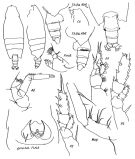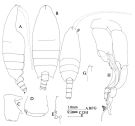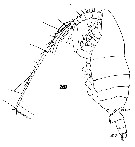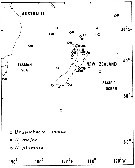|
|
 |
|
Calanoida ( Order ) |
|
|
|
Clausocalanoidea ( Superfamily ) |
|
|
|
Aetideidae ( Family ) |
|
|
|
Undeuchaeta ( Genus ) |
|
|
| |
Undeuchaeta major Giesbrecht, 1888 (F,M) | |
| | | | | | | Syn.: | Undeuchäta major Giesbrecht, 1888; 1892 (p.227, 232, figs.F);
? Euchaeta autralis Brady, 1883 (p.65);
Undeuchaete major : With, 1915 (p.136, figs.F,M);
Chirundina angulata Sars, 1905 b (p.13);
? U. major (M) : Esterly, 1905 (p.148, figs.M);
no U. incisa Esterly, 1911 (p.319) | | | | Ref.: | | | Giesbrecht & Schmeil, 1898 (p.34, Rem. F); ? Esterly, 1905 (p.148, figs.F, non M); Farran, 1908 b (p.37); A. Scott, 1909 (p.61, Rem.); Wolfenden, 1911 (p.243); With, 1915 (p.136, figs.F,M, Rem.); Sars, 1925 (p.81, figs.F,M); Farran, 1926 (p.254); 1929 (p.208, 233); Wilson, 1932 a (p.60, figs.F,M); Rose, 1933 a (p.108, figs.F,M); Jespersen, 1940 (p.26); Lysholm & al., 1945 (p.19); Sewell, 1947 (p.104); C.B. Wilson, 1950 (p.347, fig.M, juv.); Brodsky, 1950 (1967) (p.183, figs.F,M); Vervoort, 1952 h (n°49, p.3, figs.F,M); Tanaka, 1957 b (p.202, figs.F,M); Vervoort, 1957 (part., p.71, Rem.); Vervoort, 1963 b (part., p.154); Paiva, 1963 (p.38, figs.F,M); Owre & Foyo, 1967 (p.50, figs.F,M); Grice & Hulsemann, 1968 (p.329, Rem.); Tanaka & Omori, 1970 b (p.144); Bradford, 1970 a (p.354, figs.F); Morioka, 1972 a (p.314); Bradford & Jillett, 1980 (p.80, figs.F,M, fig.73, distribution chart); Björnberg & al., 1981 (p.605, 632, fig.M); Vaupel Klein, 1984 a (p.53, 54, Rem.); Markhaseva, 1996 (p.305, figs.F,M); Chihara & Murano, 1997 (p.689, Pl.48,49: F,M); Bradford-Grieve & al., 1999 (p.880, 923, figs.F,M); Vives & Shmeleva, 2007 (p.603, figs.F,M, Rem.) |  issued from : O. Tanaka in Publ. Seto Mar. Biol. Lab., 1957 b, 6 (2). [Fig.59, p.202]. Female (from Sagami): a, habitus (dorsal aspect); b, head (lateral aspect, left side); c, last thoracic segment (lateral aspect, left side); d, idem (lateral aspect, left side); e, genital segment (lateral aspect, right side); f, idem (ventral aspect); g, P1; h, inner margin of firdt basal joint of P4. Male: i, head (lateral aspect, left side); j, last thoracic segment (lateral aspect, left side); k, P5. Nota Female: - Cephalothorax about 4 times the abdomen length (3.55 : 0.88). - Forehead with a median crest. - Posterolateral corners of last thoracic segment asymmetrical; right side not pointed at apex. - Abdomen 4-segmented; segments and caudal rami in proprtional lengths 47 : 23 : 18 : 2 : 10 = 100. - Genital segment asymmetrical, right side with a small protuberance on lateral margin about the middle; a sharp spine on the ventral side near the genital opening. - A1 23-segmented; extends to the end of the 2nd abdominal segment. - A2 exopod about 1.7 times as long as endopod. Nota Male: - Cephalothorax about 2.89 times the abdomen length (4.89 : 1.18). - Forehead with a median crest. - Posterolateral corners of last thoracic segment regularly rounded. - Abdomen 5-segmented; segments and caudal rami in proportional lengths 18 : 28 : 23 : 20 : 3 : 8 = 100. - Caudal rami as long as wide. - A1 21-segmented, extends to distal end of 2nd abdominal segment. - P5 resemble those of U. plumosa; endopod of left leg shorter than the 1st segment of exopodite of the same leg.
|
 issued from : E.L. Markhaseva in Proc. Zool. Inst. RAN, St. Petersburg, 1996, 268. [p.306, Fig.246]. Female. genital field (specimen from NW Pacif.), other figures from NW Pacif.: Izu-Nonin Trench). Ce: forehead (lateral); P.md: mandibular palp.
|
 issued from : E.L. Markhaseva in Proc. Zool. Inst. RAN, St. Petersburg, 1996, 268. [p.307, Fig.247]. Male. P5(a): fifth legs (from NW Pacif: IIzu-Bonin Trench); other figures from N Atlant.). Re: exopod.
|
 issued from : J.M. Bradford & J.B. Jillett in Mem. N.Z. oceanogr. Inst., 86, 1980. [p.82, Fig.57]. Female: A, habitus (lateral right side); B, idem (dorsal); C, genital segment (lateral right side); D, idem (dorsal); E, inner edge of basipod 1 of P4. Nota: The teeth on basipod 1 of P4 are similar to those found in U. incisa. These teeth may not always be present as in one specimen there were two teeth on one side and one on the the other and the border was wrinkled. Male: F, habitus (dorsal); G, forehead (lateral view); H, P5.
|
 issued from : J.M. Bradford in N.Z. Jl Mar. Freshw. Res., 1970, 4 (4). [p.354, Figs 20-22]. Female (off Kaikoura, New Zealand): 20, forehead with proximal segment of A1 (lateral right side); 21, genital segment (dorsal); 22, genital segment (lateral left side). Scale bars represent 1.0 mm in 20 and 0.1 mm in 21 and 22.
|
 Issued from : G.O. Sars in Résult. Camp. Scient. Prince Albert I, 69, pls.1-127 (1924). [Pl.XXIII, figs.7-12]. Female: 7, habitus (dorsal); 8, idem (lateral left side); 9, forehead (lateral); 10, posterior corner cephalothorax and 1st and 2nd urosomal segments (lateral left side). Male: 11,habitus (lateral left side); 12, P5.
|
 issued from : C.O. Esterly in Univ. Calif. Publs Zool., 1905, 2 (4). [p.149, Fig.16, a, e]. Female (from San Diego Region): a, habitus (lateral); e, exopodite of Mx1. Nota: Head with median crest. Genital segment with protrusion on right side and a hooked pointed appendage at the right of the genital opening.
|
 issued from : C.O. Esterly in Univ. Calif. Publs Zool., 1905, 2 (4). [p.149, Fig.16, b, c, d, f]. With doubt. Male: b, habitus (lateral); c-d, forehead (dorsal) and lateral, rsepectively); f, distal portion of left P5 (Re2, Re3 = respective segments of exopod). Body size: 6-6.5 mm.
|
 Issued from : W. Giesbrecht in Systematik und Faunistik der Pelagischen Copepoden des Golfes von Neapel und der angrenzenden Meeres-Abschnitte. - Fauna Flora Golf. Neapel, 1892, 19 , Atlas von 54 Tafeln. [Taf.37, Fig.59]. Female: 59, habitus (lateral).
|
 Issued from : W. Giesbrecht in Systematik und Faunistik der Pelagischen Copepoden des Golfes von Neapel und der angrenzenden Meeres-Abschnitte. - Fauna Flora Golf. Neapel, 1892, 19 , Atlas von 54 Tafeln. [Taf.37, Figs.56, 57]. Female: 56, urosome (lateral); 57, same (ventral).
|
 Undeuchaeta major Undeuchaeta major female: 1 - Cephalon with crest. 2 - Posterior corners of last thoracic segment nearly aqually prolonged, triangular (lateral and dorsal view).
|
 Undeuchaeta major Undeuchaeta major male: 1 - Cephalon with crest. 2 - Exopodal segment 2 of left P5 1.5, or less longer than wide.
|
 issued from : O. Tanaka in Publ. Seto Mar. Biol. Lab., 1957 b, 6 (2). [p.203]. Female: A1: Proportional lengths of segments. - A1 23-segmentted; segments 17 more than 2 times as long as the 12th, wherea, according to With, it is scarcely, not distinctly twice as long as the 12th
| | | | | Compl. Ref.: | | | Cleve, 1904 a (p.198); Pearson, 1906 (p.15, Rem.); Wilson, 1942 a (p.210); Lysholm & Nordgaard, 1921 (p.17); Hardy & Gunther, 1935 (1936) (p.159, Rem.); Sewell, 1948 (p.331, 500, 512, 513, 516, 519, 525, 531, 545, 549, 566); King & Hida, 1955 (p.11); Østvedt, 1955 (p.15: Table 3), p.63; Fagetti, 1962 (p.20); Grice, 1963 a (p.495); Björnberg, 1963 (p.36, Rem.); De Decker & Mombeck, 1964 (p.14); Grice & Hulsemann, 1965 (p.223); 1967 (p.15); 1968 (tab.2); Morris, 1970 (p.2300); Park, 1970 (p.476); Timonin, 1971 (p.281, trophic group); Roe, 1972 (p.277, tabl.1, tabl.2); 1972 a (p.340); Bainbridge, 1972 (p.61, Appendix Table III: occurrence); Björnberg, 1973 (p.325, 389); Vives & al., 1975 (p.41, tab.II, III, XII); Deevey & Brooks, 1977 (p.256, tab.2, Station "S"); Carter, 1977 (1978) (p.35); Dessier, 1979 (p.205); Ponomareva & Suslyayev, 1980 (p.196, movement); Pipe & Coombs, 1980 (p.223, vertical occurrence); Vives, 1982 (p.291); Gaudy & Boucker, 1983 (p.37, Table 1, Rem.: metabolism); Brenning, 1983 (p.5, Rem.); Guangshan & Honglin, 1984 (p.118, tab.); Tremblay & Anderson, 1984 (p.4, Rem.); Roe, 1984 (p.357); Brenning, 1985 a (p.28, Table 2); Madhupratap & Haridas, 1986 (p.105, tab.1); Lozano Soldevilla & al., 1988 (p.58); Heinrich, 1990 (p.17); Suarez & al., 1990 (tab.2); Hattori, 1991 (tab.1, Appendix); Suarez & Gasca, 1991 (tab.2); Suarez, 1992 (App.1); Hays & al., 1994 (tab.1); Shih & Young, 1995 (p.67); Errhif & al., 1997 (p.423); Suarez-Morales & Gasca, 1998 a (p108); Lapernat, 2000 (tabl.3, 4); Razouls & al., 2000 (p.343, Appendix); Pakhomov & al., 2000 (p.1663, Table 2, transect Cape Town-SANAE antarctic base); Holmes, 2001 (p.51); Sameoto & al., 2002 (p.13); Beaugrand & al., 2002 (p.179, figs.5, 6); Yamaguchi & al., 2002 (p.1007, tab.1); Hsiao & al., 2004 (p.325, tab.1); CPR, 2004 (p.63, fig.191); Ikeda & al., 2006 (p.1791,Table 2); Dur & al., 2007 (p.197, Table IV); Gaard & al., 2008 (p.59, Table1, N Atlantic Mid-Ridge); Galbraith, 2009 (pers. comm.); Park & Ferrari, 2009 (p.143, Table 5, Appendix 1, biogeography); Schnack-Schiel & al., 2010 (p.2064, Table 2: E Atlantic subtropical/tropical); Dias & al., 2010 (p.230, Table 1); Hsiao S.H. & al., 2011 (p.475, Appendix I); Batten & Walne, 2011 (p.1643, Table I, abundance vs temperature interannual variability); Teuber & al., 2013 (p.1, Table 1, abundance vs oxygen minimum zone); in CalCOFI regional list (MDO, Nov. 2013; M. Ohman, comm. pers.); Hirai & al., 2013 (p.1, Table I, molecular marker); Sano & al., 2013 (p.11, Table 2, 5, figs.5, 7, 8, 9, A1, feeding habits, vertical distribution, Rem.: p.21); Lidvanov & al., 2013 (p.290, Table 2, % composition); Bonecker & a., 2014 (p.445, Table II: frequency, horizontal & vertical distributions); Bode & al., 2015 (p.268, Table 1, chemical components, trophic level, geographic zone) | | | | NZ: | 23 | | |
|
Distribution map of Undeuchaeta major by geographical zones
|
| | | | | | | | | | | | | | |  Issued from : J.M. Bradford & J.B. Jillett in New Zealand Ocean. Inst. Memoir, 86, 1980. [p.90-91, Fig.69]. Issued from : J.M. Bradford & J.B. Jillett in New Zealand Ocean. Inst. Memoir, 86, 1980. [p.90-91, Fig.69].
Distribution of several species of Undeuchaeta in the Tasman Sea and around New Zealand. |
 Issued from : M. Sano, K. Maki, Y. Nishibe, T. Nagata & S. Nishida in Progr. Oceanogr., 2013, 110. [p.20, Fig.10]. Issued from : M. Sano, K. Maki, Y. Nishibe, T. Nagata & S. Nishida in Progr. Oceanogr., 2013, 110. [p.20, Fig.10].
Vertical distribution of eight copepod species across 0-1000 m in Sagami bay in 21-27 April 2009.
White and black boxes denote daytime and nighttime distributions. Scaphocalanus echinatus/em> is taken from Kuriyama & Nishida (2006).
Plankton and water samples collected from a fixed station (35°00'N, 139°20'E) using MTD horizontal closing nets (0.33 mm mesh aperture) at 15 depths (0, 50, 95, 100, 150, 195, 200, 295, 300, 395, 400, 500, 600, 800, 1000 m) during both day and night.
Atomic C:N ratio (mean ±SD) = 5.5 ±0.8, n = 10. |
 Issued from : M. Sano, K. Maki, Y. Nishibe, T. Nagata & S. Nishida in Progr. Oceanogr., 2013, 110. [p.19, Figs8, 9]. Issued from : M. Sano, K. Maki, Y. Nishibe, T. Nagata & S. Nishida in Progr. Oceanogr., 2013, 110. [p.19, Figs8, 9].
Second maxilla 'Mx2) and maxiliped (Mxp) from Undeucharta major.
Scale bars: 200 µm.
Nota: The C and N values coincided with the plots assumed for potential consumers of oncaeid copepods and epipelagic particulate organic matter (POM). The microscopic gut-content analysis indicated the ingestion of crustaceans fragments and absence of autofluorescence in all specimens, as well as the presence of maxillipeds of oncaeid copepods and A2 of corycaeid copepods in many specimens. The observations indicate that the species mainly ingested crustaceans, diatom particles may be derived from the gut contents of ingested zooplankton. Oncaeids are one of the most numerous groups in oceaniccopepod communities, particularly in meso- and bathypelagic zones (c.a Böttger-Schnack, 1996; Yamaguchi & al., 2002).
Compare appendage structure and setal armement with Euchirella rostrata, Chirundina streetsii, Pleuromamma xiphia, Scaphocalanus echinatus, Scottocalanus helenae, Scottocalanus securifrons, Spinocalanus magnus and calanus sinicus for interpreted particles catching. |
| | | | Loc: | | | Cosmopolite (tropical & temperate); except Arctic and in The Mediterranean Sea; Antarct. (SW Pacif., South Georgia), sub-Antarct. (SW Atlant., Indian, SE Pacif.), South Africa (E), Atlant. (tropical and temperate), Brazil, off Rio de Janeiro, Caribbean Sea, G. of Mexico, Florida, G. of Guinea , off Lagos, off Mauritania-NW Cape Verde Is., Morocco-Mauritania, Canary Is., off Madeira, Ibero-moroccan Bay, off W Cabo Finisterre, Sargasso Sea, off Bermuda: Station "S" (32°10'N, 64°30'W), G. of Maine, off Woods Hole, off Nova Scotia E, Gulf of St. Lawrence, S Iceland, Wyville Thomson Ridge, S Faroe Is., Ireland (W, S), off SW Ireland, Norway Sea, North Sea, G. of Suez, Arabian Sea, Natal, Madagascar (Nosy Bé), Indian, S Indian (subtropical convergence), Indonesia-Malaysia, China Seas (East China Sea, South China Sea), E, Taiwan (SW, E), Pacif. (tropical & temperate), off S Hawaii S, Marianne Trench & Izu-Bonin Trench, Japan, Sagami Bay, off Sanriku, off Hokkaido, Station Knot, Okhotsk Sea, S G. of Alaska, Vancouver Is., ? California, Pacif. (W equatorial), off S Australia, New Zealand, Pacif. (SE tropical), off Juan Fernandez Is., Chile (N & S).
Type locality: 20°N, 173°E. | | | | N: | 110 | | | | Lg.: | | | (1) F: 5,1; (5) F: 6,4-4,8; (7) F: 4,92; M: 4,92; (14) F: 5,3-4,15; M: 4,25-3,9; (22*) F [= M]: 5,5-4,5; M [= F]: 6,5-6; (37) F: 5,5-4,15; M: 4,92-3,9; (38) F: 4,8; M: 4,74-4,26; (45) F: 5,5-4,5; M: 4,9-4; (46) F: 4,5; (56) F: 4,43; M: 4,12; (73) F: 5,2-4,77; M: 4,31-4,1; (112) F: 5,2-4,2; M: 4,5-4; ? (142) F: 5,5-4,5; (199) F: 5,28-4,64; M: 4,64-4,26; (201) F: 5,25-4,5; M: 4,4-3,9; (202) F: 4,5-5,28; M: 4,26-4,92; (237) F: 3,5-4,0; M: 3,0-3,5; (313) F: 4,7; 5,0; M: 4,4; (1109) M: 4,25-4,18; {F: 3,50-6,50; M: 3,00-5,50}
* The lengths indicate by Brodsky, 1950 (1967) for males and females appear reversed. | | | | Rem.: | epi, meso & bathypelagic.
Sampling depth (Antarct., sub-Antarct.): 50-750-2000 m.
Observed off Macaé (S Brazil) by Dias & al. (2010) in Intermediate Antarctic water.
Sargasso Sea: 500-2000 m (Deevey & Brooks, 1977, station "S"). 510-530 m (Pipe & Coombs, 1980 at 60°N, 07°W).
For Vervoort (1957, p.72) the male from South Tasmania (44°35’S, 147°35’E) compared with the specimens in the ‘Siboga’ and ’Snellius’ collections shows : a distinct crest present in both females and male in the adult stage ; in the female the hooked spine on the right side of the genital opening varies considerably in length and development ; a certain amount of variability is also to be observed in the development of the postero-lateral thoracic border. In the ‘Snellius’ collection (from Indonesia : Ombai Strait) a female closely resembles the description and figures of Mesundeuchaeta asymmetrica Wolfenden (1911) ; the most striking character, according to Wolfenden, is the shape of the last thoracic somite and of the genital somite. Vervoort is of the opinion that Wolfenden’s Mesundeuchaeta asymmetrica is identical with Undeuchaeta major.
For Grice & Hulsemann (1968, p.329) the 1st basipodal segments of P4 examined in 28 females show: most of them have 2 or 3 small spines on these segments, in only 2 specimens are the spines absent.
After Ponomareva & Suslyayev (1980, p.196) the average rates of movement is 3.8-29.1 m/hr.
Timonin (1971, p.282) considers the trophic interrelations in the equatorial and tropical Indian Ocean, and divides the plankters into 6 trophic groups from the litterature and the results of studies of mouth-parts structure and intestine content. This species is omnivorous. After Sano & al. (2013, p.21) this species is considered omnivore/detritivores based on previous studies, in Sagami Bay the species is assumed to be carnivores, particularly feeding on oncaeid copepods.
: R. Stephen, 2007 : Data sheets of NIO, Kochi, India (on line). | | | Last update : 23/01/2021 | |
|
|
 Any use of this site for a publication will be mentioned with the following reference : Any use of this site for a publication will be mentioned with the following reference :
Razouls C., Desreumaux N., Kouwenberg J. and de Bovée F., 2005-2025. - Biodiversity of Marine Planktonic Copepods (morphology, geographical distribution and biological data). Sorbonne University, CNRS. Available at http://copepodes.obs-banyuls.fr/en [Accessed December 26, 2025] © copyright 2005-2025 Sorbonne University, CNRS
|
|
 |
 |















